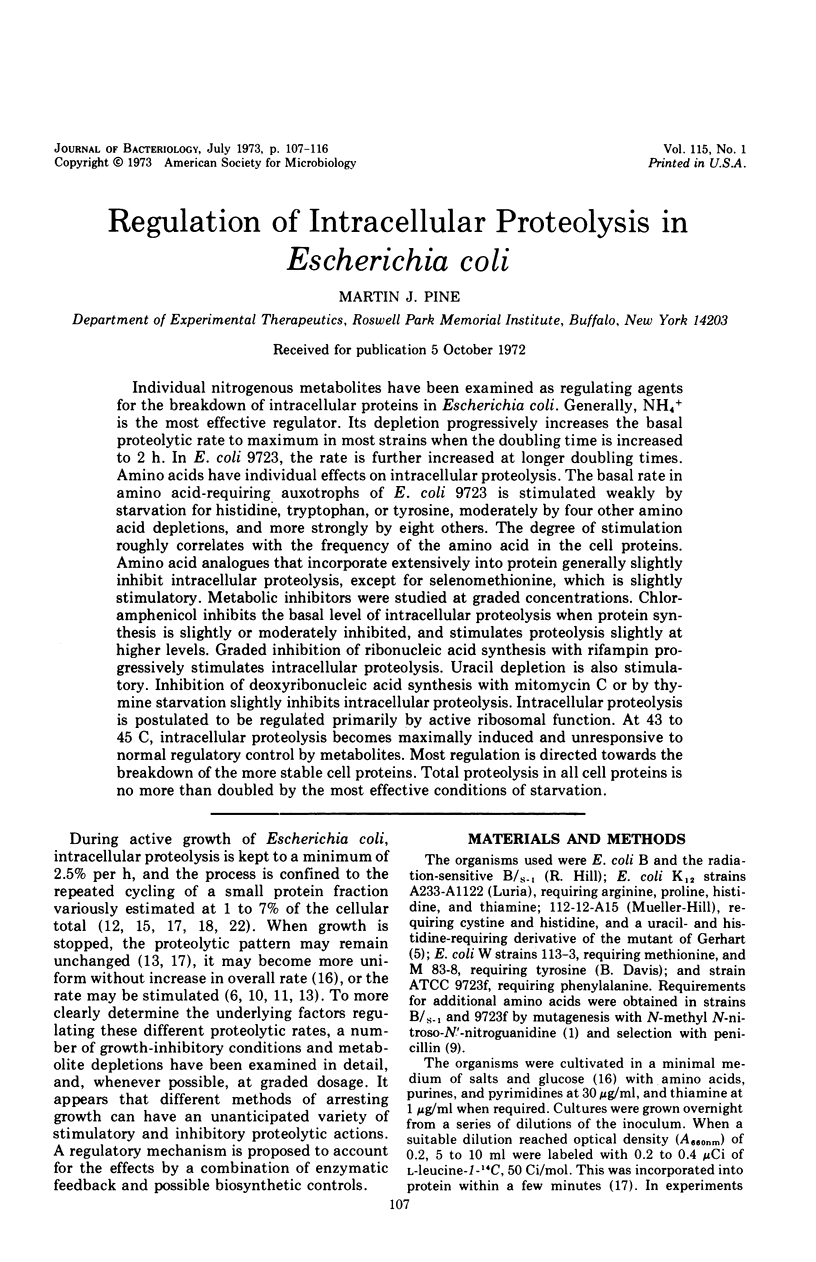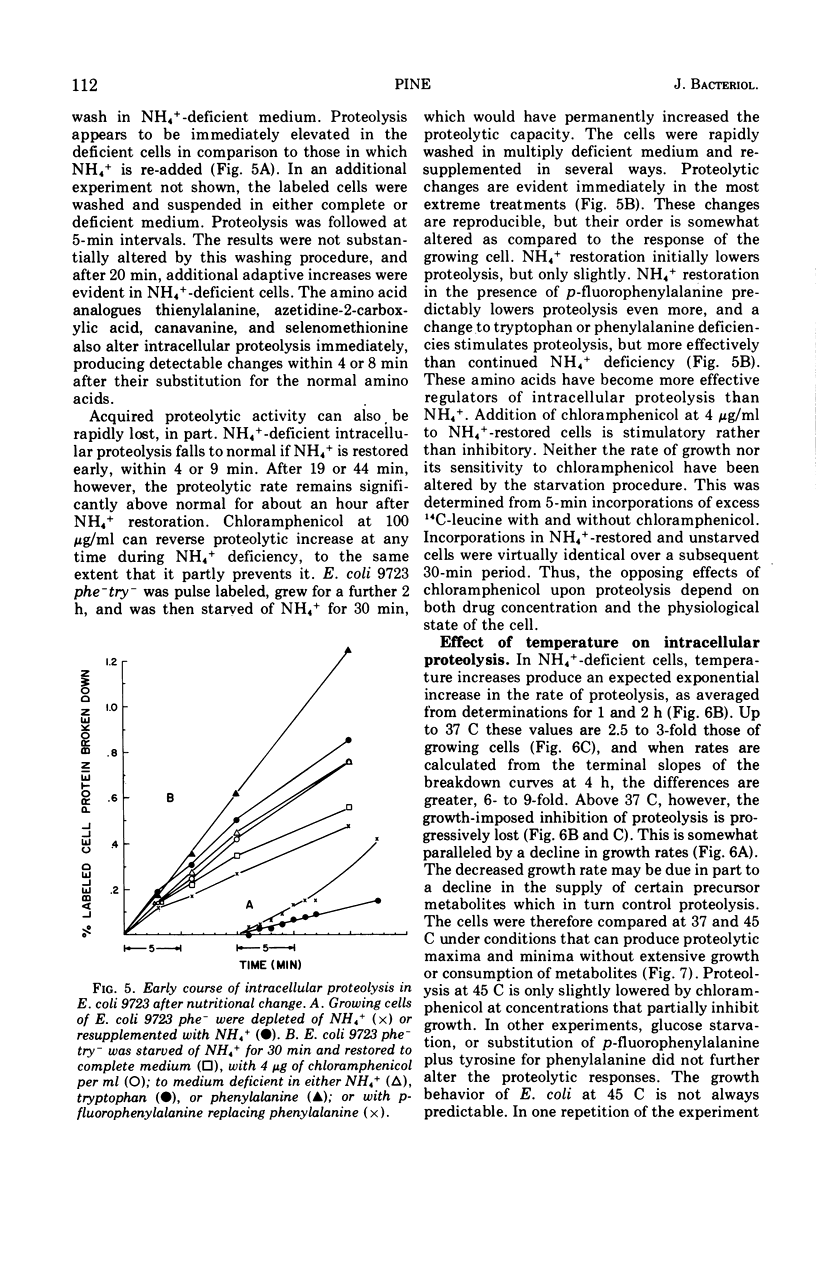Abstract
Individual nitrogenous metabolites have been examined as regulating agents for the breakdown of intracellular proteins in Escherichia coli. Generally, NH4+ is the most effective regulator. Its depletion progressively increases the basal proteolytic rate to maximum in most strains when the doubling time is increased to 2 h. In E. coli 9723, the rate is further increased at longer doubling times. Amino acids have individual effects on intracellular proteolysis. The basal rate in amino acid-requiring auxotrophs of E. coli 9723 is stimulated weakly by starvation for histidine, tryptophan, or tyrosine, moderately by four other amino acid depletions, and more strongly by eight others. The degree of stimulation roughly correlates with the frequency of the amino acid in the cell proteins. Amino acid analogues that incorporate extensively into protein generally slightly inhibit intracellular proteolysis, except for selenomethionine, which is slightly stimulatory. Metabolic inhibitors were studied at graded concentrations. Chloramphenicol inhibits the basal level of intracellular proteolysis when protein synthesis is slightly or moderately inhibited, and stimulates proteolysis slightly at higher levels. Graded inhibition of ribonucleic acid synthesis with rifampin progressively stimulates intracellular proteolysis. Uracil depletion is also stimulatory. Inhibition of deoxyribonucleic acid synthesis with mitomycin C or by thymine starvation slightly inhibits intracellular proteolysis. Intracellular proteolysis is postulated to be regulated primarily by active ribosomal function. At 43 to 45 C, intracellular proteolysis becomes maximally induced and unresponsive to normal regulatory control by metabolites. Most regulation is directed towards the breakdown of the more stable cell proteins. Total proteolysis in all cell proteins is no more than doubled by the most effective conditions of starvation.
Full text
PDF









Selected References
These references are in PubMed. This may not be the complete list of references from this article.
- Brunschede H., Bremer H. Synthesis and breakdown of proteins in Escherichia coli during amino-acid starvation. J Mol Biol. 1971 Apr 14;57(1):35–57. doi: 10.1016/0022-2836(71)90118-5. [DOI] [PubMed] [Google Scholar]
- COWIE D. B., COHEN G. N. Biosynthesis by Escherichia coli of active altered proteins containing selenium instead of sulfur. Biochim Biophys Acta. 1957 Nov;26(2):252–261. doi: 10.1016/0006-3002(57)90003-3. [DOI] [PubMed] [Google Scholar]
- GORINI L., KAUFMAN H. Selecting bacterial mutants by the penicillin method. Science. 1960 Feb 26;131(3400):604–605. doi: 10.1126/science.131.3400.604. [DOI] [PubMed] [Google Scholar]
- Gerhart J. C., Holoubek H. The purification of aspartate transcarbamylase of Escherichia coli and separation of its protein subunits. J Biol Chem. 1967 Jun 25;242(12):2886–2892. [PubMed] [Google Scholar]
- Goldberg A. L. A role of aminoacyl-tRNA in the regulation of protein breakdown in Escherichia coli. Proc Natl Acad Sci U S A. 1971 Feb;68(2):362–366. doi: 10.1073/pnas.68.2.362. [DOI] [PMC free article] [PubMed] [Google Scholar]
- Goldberg A. L. Degradation of abnormal proteins in Escherichia coli (protein breakdown-protein structure-mistranslation-amino acid analogs-puromycin). Proc Natl Acad Sci U S A. 1972 Feb;69(2):422–426. doi: 10.1073/pnas.69.2.422. [DOI] [PMC free article] [PubMed] [Google Scholar]
- Goldberg A. L. Effects of protease inhibitors on protein breakdown and enzyme induction in starving Escherichia coli. Nat New Biol. 1971 Nov 10;234(45):51–52. doi: 10.1038/newbio234051a0. [DOI] [PubMed] [Google Scholar]
- MANDELSTAM J. Turnover of protein in growing and non-growing populations of Escherichia coli. Biochem J. 1958 May;69(1):110–119. doi: 10.1042/bj0690110. [DOI] [PMC free article] [PubMed] [Google Scholar]
- Nath K., Koch A. L. Protein degradation in Escherichia coli. I. Measurement of rapidly and slowly decaying components. J Biol Chem. 1970 Jun 10;245(11):2889–2900. [PubMed] [Google Scholar]
- Nath K., Koch A. L. Protein degradation in Escherichia coli. II. Strain differences in the degradation of protein and nucleic acid resulting from starvation. J Biol Chem. 1971 Nov 25;246(22):6956–6967. [PubMed] [Google Scholar]
- Pine M. J. Heterogeneity of protein turnover in Escherichia coli. Biochim Biophys Acta. 1965 Jul 8;104(2):439–456. doi: 10.1016/0304-4165(65)90349-1. [DOI] [PubMed] [Google Scholar]
- Pine M. J. Metabolic control of intracellular proteolysis in growing and resting cells of Escherichia coli. J Bacteriol. 1966 Oct;92(4):847–850. doi: 10.1128/jb.92.4.847-850.1966. [DOI] [PMC free article] [PubMed] [Google Scholar]
- Pine M. J. Response of intracellular proteolysis to alteration of bacterial protein and the implications in metabolic regulation. J Bacteriol. 1967 May;93(5):1527–1533. doi: 10.1128/jb.93.5.1527-1533.1967. [DOI] [PMC free article] [PubMed] [Google Scholar]
- Pine M. J. Steady-state measurement of the turnover of amino acid in the cellular proteins of growing Escherichia coli: existence of two kinetically distinct reactions. J Bacteriol. 1970 Jul;103(1):207–215. doi: 10.1128/jb.103.1.207-215.1970. [DOI] [PMC free article] [PubMed] [Google Scholar]
- Pine M. J. Turnover of intracellular proteins. Annu Rev Microbiol. 1972;26:103–126. doi: 10.1146/annurev.mi.26.100172.000535. [DOI] [PubMed] [Google Scholar]
- Prouty W. F., Goldberg A. L. Effects of protease inhibitors on protein breakdown in Escherichia coli. J Biol Chem. 1972 May 25;247(10):3341–3352. [PubMed] [Google Scholar]
- SPAHR P. F. Amino acid composition of ribosomes from Escherichia coli. J Mol Biol. 1962 May;4:395–406. doi: 10.1016/s0022-2836(62)80020-5. [DOI] [PubMed] [Google Scholar]
- Sussman A. J., Gilvarg C. Protein turnover in amino acid-starved strains of Escherichia coli K-12 differing in their ribonucleic acid control. J Biol Chem. 1969 Nov 25;244(22):6304–6306. [PubMed] [Google Scholar]
- Willetts N. S. Intracellular protein breakdown in growing cells of Escherichia coli. Biochem J. 1967 May;103(2):462–466. doi: 10.1042/bj1030462. [DOI] [PMC free article] [PubMed] [Google Scholar]


